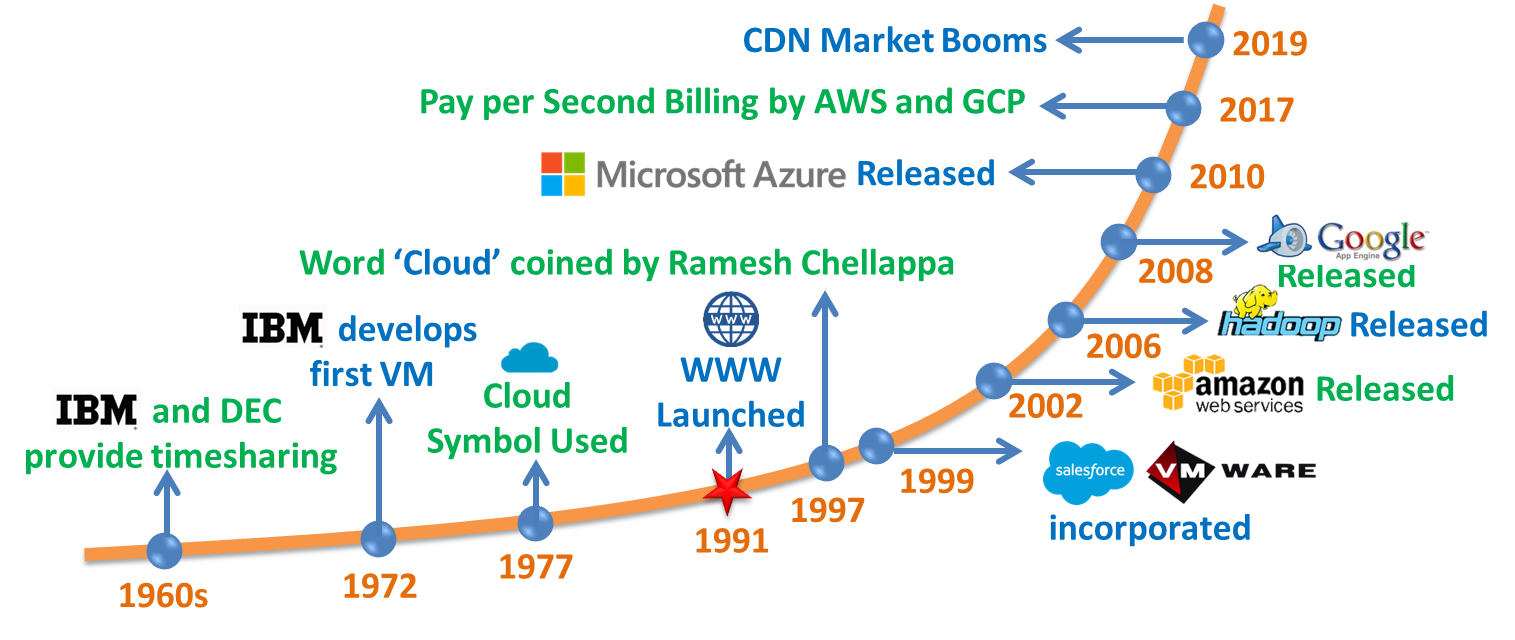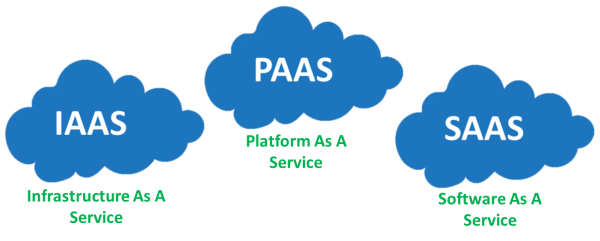
Cloud Computing
- Categories Cloud Computing, Emerging Trends
Hello, In this post we will learn about cloud computing.
Cloud Computing is nothing but availability of processing power, storage and applications delivered on demand to the customers over the internet . For example when we say processing power, that is the High End servers which are made available for hosting your sites, running your enterprise applications and more. Or when we say storage it is a place to keep your data, Music, photographs and other media online like on MySQL database or Google Drive.
When we talk of applications they are all the applications you use over internet This could be system software like virus checking or providing some services like Netflix or Roblox or collaboration apps like Microsoft teams, Gmail etc.

Cloud Computing
Companies like Google, Amazon, Microsoft, IBM and many others provide you such Cloud Platforms.

Examples of Cloud Computing
Why do we need cloud computing?
Before the internet became popular, most companies had In-premise installation. This means if they needed computer they had to buy one. On top of investing in the hardware, they also had to invest in software, electricity for power and cooling, security, data backup, disaster recovery and maintenance too. So in other words cost just kept on going up! On top of it most of the time the computing power remained unused and was utilized only 30%-40%.

IN-PREMISE INSTALLATION
Benefit Of Cloud Computing
- The benefit of cloud computing is lower cost of ownership i.e. rather than owning their own computing infrastructure or data centres, companies can rent anything from storage to application from a cloud service provider.
- In this way they don’t have to worry about upgrades, and maintenance.
- They get offsite storage which increases collaboration amongst employees.
- They avoid the upfront cost and they pay only for what they use.

Benefit of Cloud Computing
History Of Cloud Computing
- If you look back at history, in 1960s when the computers were very expensive, IBM and DEC used to provide their computers for timesharing. You could submit jobs to be run on IBM mainframes.
- In 1972 IBM developed the first Virtual Machine.
- The cloud symbol was used way back in 1977.
- Once the internet and world wide web came into picture, Many telecommunication companies offered VPN or Virtual Private network and Compaq started offering online disk space were you could keep files.
- The word cloud itself was coined by Ramesh Chellappa in 1997. The word cloud was used as a metaphor for the Internet and cloud symbol was used to represent network of computing equipment.
- In 1999 Cloud companies such as Salesforce and VM Ware were incorporated.
- In 2002 Amazon launched Amazon Web Services, In 2006 Hadoop was Released.
- In 2008 Google launched Google App Engine
- n 2010 Mirosoft released Microsoft Azure and in next few years almost everyone jumped onto cloud computing bandwagon.

History of Cloud Computing
Types of Cloud Computing
Based upon deployment model, cloud services can be leveraged in three different ways, public, private and hybrid.

Types of Cloud Computing
Difference Between Public, Private And Hybrid
To understand the Difference Between them, lets take an example. Suppose you need to travel. A Bus, Private Car and Rental Car can be used to explain Public, Private and Hybrid Cloud Computing.
- Bus is a public transport which is widely available but you need to share it with others. It is cheaper and you only pay for the distance you travel.
- On the other side you can opt to buy your own car. You put the upfront money to buy the car and also pay for regular maintenance of it. The plus side is the privacy and flexibility you get along with it which is not possible in public transport.
- A middle path is taxi service. For a higher fee you do get your privacy while using the car but you do not own the car. This is the hybrid model.
Public

- Share with others
- Cheaper
- Pay only for distance you travel
- No maintenance
Private

- Upfront funding
- Maintenance Charges
- Privacy
- Flexibility
Hybrid

- Higher fee
- Privacy
- Flexibility
- No maintenance
Comparison Between Different Types of Cloud
Public
- Infrastructure Owned And Operated By Cloud Service Provider
- Pay only for what you use
- Reduced Complexity
- Quicker Setup
- Lesser Security
- Limited Flexibility
Private
- Self Owned Data Centres and software for private use
- Dedicated
- Secure
- Regulation Compliant
- Highly customizable
- Higher Investment
- Maintenance cost
Hybrid
- Mix and match Public and Private Cloud based upon requirements
- Improved security
- Minimal security risk
- High flexibility
- Expensive in long run
- Complexity is high
Types of Cloud Computing
From services perspective, there are three types of cloud, IAAS which is Infrastructure as a service, PAAS which is Platform as a serviceand SAAS which is software as a service.

Types of Cloud Computing
A Washing Machine can be used to explain IAAS, PAAS and SAAS Cloud Computing.
Suppose you want to wash or laundry your clothes.
- The first option is IAAS or Infrastructure at home option where you have a washing machine at home and everything from washing to drying is managed by you. You need to buy washing powder and anything else you need.
- Next is PAAS or Platform as a service. Here you go to a Laundromat or common washing machine area to do your washing. Here the place may also provide you with detergent, softener for some extra fee.
- Next is Software as a service or SAAS here you call for Laundry service and Laundry man comes and picks and returns the clothes to you at your door step.
IAAS

Washing Machine at home
- End to End washing, drying managed by you
- Need to arrange for detergent, softener on your own
PAAS

Self Service Washing Machines
- No need for washing machine, detergent etc.
- Provides additional add on services, such as detergent etc.
SAAS

Call for Laundry Service
- Laundry man comes to pick and return the clothes
- No need for washing machine, detergent etc.
Based upon who handles what responsibility, IAAS, PAAS and SAAS Cloud can be represented as shown.
- Similarly primary thing that differentiates the three main categories of cloud computing from one another is who manages the different pieces of the IT stack.
- In traditional On-premise means that a company has invested on setting up its own IT environment, means it has setup its hardware and software locally and does its maintenance on its own.
- Infrastructure as a service( IaaS) :
- The cloud provider provides the infrastructure and serves the complete data center framework on pay as you go model, eliminating the need for resource-intensive, on-site installations.
- You will still have to take care of the complete software setup part of it starting from OS to middleware, databases and applications that are needed for your business.
- Platform as a service(PaaS) :
- The cloud service provider serves a web-based environment where developers can build or deploy cloud apps.
- It maintains the Operating system, database and programming language that organizations can use to develop cloud-based software, without having to maintain the underlying elements.
- Software as a service (SAAS) :
- It is cloud-based software available for purchase on a subscription basis.
- The cloud service provider provides variety of services, such as applications for mail, collaboration, Data storage, backup and a lot more.

Responsibility of IAAS, PAAS and SAAS
To sum up, each cloud model offers its specific features, and you need to choose the one that suits your business needs.
You may also like

Mobile Telecommunication Technologies

Machine Learning

